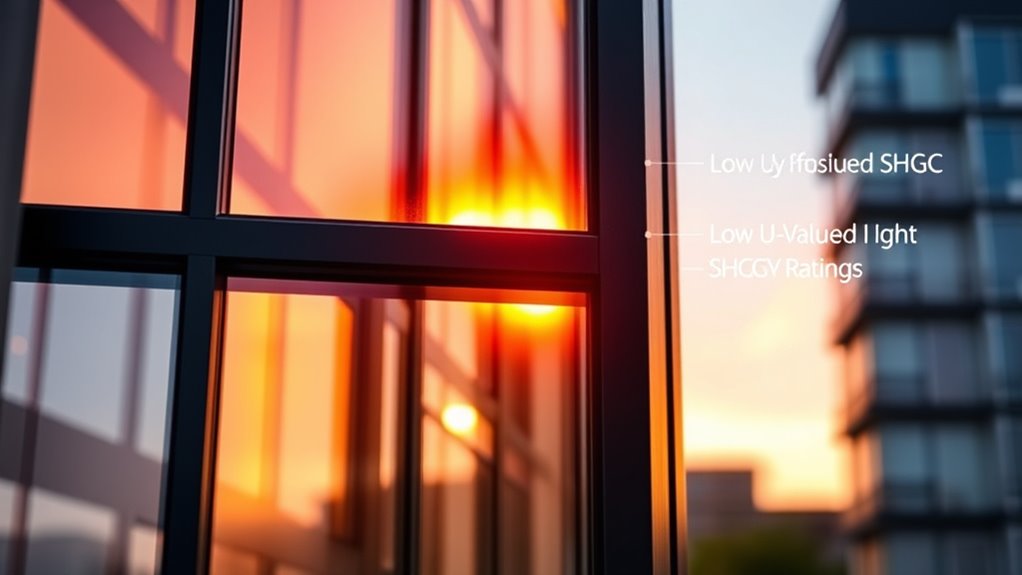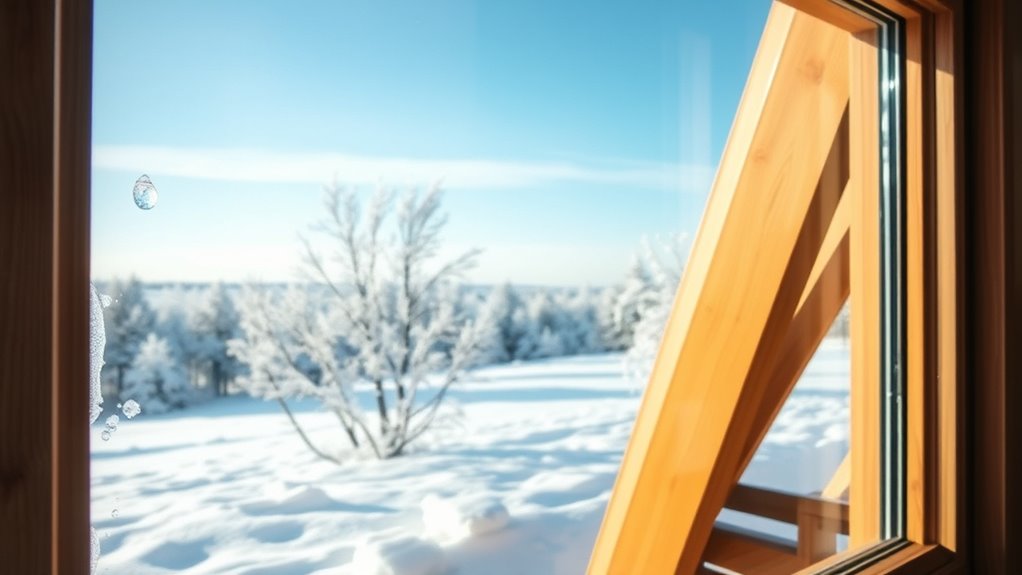High-performance windows improve your home’s energy efficiency by balancing U-value and SHGC. The U-value measures how well a window insulates—lower numbers mean better insulation. SHGC indicates how much solar heat passes through—lower values reduce cooling costs in summer, while higher ones help warm your home naturally in winter. Choosing the right combination depends on your climate and comfort needs. Continue exploring to see how these metrics can make your windows work smarter for you.
Key Takeaways
- U-value measures window insulation efficiency; lower U-values indicate better heat retention.
- SHGC assesses the amount of solar heat passing through the window; lower SHGC reduces unwanted summer heat gain.
- High-performance windows aim for low U-values to minimize heat transfer in cold climates.
- Selecting windows with appropriate SHGC balances solar gain and cooling needs based on climate.
- Combining low U-value and optimal SHGC enhances energy efficiency and indoor comfort year-round.

High-performance windows are essential for creating a more energy-efficient and comfortable home. They help you reduce energy bills and maintain a consistent indoor temperature. One of the key factors that determine a window’s performance is its ability to manage solar gain and provide effective thermal insulation. Solar gain refers to the amount of sunlight that passes through the window, contributing to the warmth inside your home. If a window allows too much solar gain, especially during hot months, it can make your living space uncomfortable and increase your cooling costs. Conversely, during colder months, you want to maximize solar gain to help warm your home naturally. High-quality windows are designed to control this balance, either by minimizing or maximizing solar gain depending on your climate and preferences.
Thermal insulation plays a crucial role in preventing heat transfer through your windows. Good insulation keeps the warm air inside during winter and the cool air inside during summer, ensuring your home stays cozy without overworking your heating or cooling systems. High-performance windows feature advanced glazing and framing materials that significantly improve thermal insulation. They often utilize multiple panes with inert gas fills, such as argon or krypton, which slow down heat transfer and keep your home warmer in winter and cooler in summer. Low-emissivity (Low-E) coatings are also commonly applied to the glass to reflect infrared heat back into the room, further enhancing insulation and reducing energy loss. Additionally, the integration of AI-powered technology in window manufacturing is beginning to optimize performance through real-time quality control and customization options.
When selecting high-performance windows, you should pay close attention to the U-value and Solar Heat Gain Coefficient (SHGC). The U-value measures how well the window insulates; lower values indicate better insulation. A window with a low U-value reduces heat transfer, which is especially important in colder climates. The SHGC indicates how much solar radiation passes through the window; a lower SHGC minimizes unwanted solar heat during summer, while a higher one can help in colder months by allowing more sunlight to warm your home. By choosing windows with the right combination of low U-value and appropriate SHGC for your climate, you optimize both energy efficiency and comfort.
Frequently Asked Questions
How Do U-Value and SHGC Impact Energy Bills?
Lower U-value and SHGC improve your energy bills by reducing heat transfer and controlling solar gain through your windows. Better window insulation keeps warm air inside during winter and cool air during summer, cutting heating and cooling costs. A lower SHGC limits solar heat entering your home, lessening the need for air conditioning. By choosing windows with ideal U-value and SHGC, you can save money while maintaining comfortable indoor temperatures.
What Window Materials Offer the Best U-Value and SHGC?
Like a knight’s armor in a medieval castle, modern window materials shield your home from energy loss. You should look for window frame options made from vinyl, fiberglass, or wood-clad materials, paired with advanced glazing technologies like low-E coatings and gas fills. These options offer excellent U-values and SHGC ratings, ensuring your windows keep heat in during winter and out during summer, saving you money and boosting comfort.
How Do Climate Zones Affect Window Selection?
Climate zone considerations are vital when selecting windows because they influence your choice of U-value and SHGC. For colder zones, you’ll want windows with low U-values to minimize heat loss, while in warmer regions, high SHGC values help reduce cooling costs. Additionally, regional energy codes often specify requirements, so you should confirm your window choices meet local standards to maximize energy efficiency and comfort.
Can High-Performance Windows Improve Indoor Comfort?
Yes, high-performance windows can markedly improve your indoor comfort. Features like window tinting reduce glare and heat gain, keeping your space cooler. Smart glass automatically adjusts its transparency, blocking heat when needed and allowing sunlight when comfortable. These technologies help maintain a consistent indoor temperature, reduce energy costs, and enhance your overall comfort, regardless of outside weather conditions.
Are There Government Incentives for Installing High-Efficiency Windows?
Yes, there are government incentives and rebate programs available for installing high-efficiency windows. These programs aim to encourage energy-saving upgrades and can help offset the costs of upgrading your windows. You should check with local, state, or federal agencies to find specific incentives in your area. Taking advantage of these rebates can make it more affordable to improve your home’s energy efficiency and indoor comfort.
Conclusion
Now that you understand the importance of U‑values and SHGC, the real question is—are your windows ready to perform at their best? Don’t settle for less when high‑performance options could transform your space. The next step could be the key to greater comfort and energy savings. Are you prepared to make the switch and reveal the full potential of your home? The choice is yours—are you ready to discover what’s possible?









